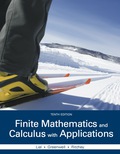
Exercises 15–18 require both the trapezoidal rule and Simpson’s rule. They can be worked without calculator programs if such programs are not available, although they require more calculation than the other problems in this exercise set.
Error Analysis The difference between the true value of an integral and the value given by the trapezoidal rule or Simpson’s rule is known as the error. In numerical analysis, the error is studied to determine how large n must be for the error to be smaller than some specified amount. For both rules, the error is inversely proportional to a power of n, the number of subdivisions. In other words, the error is roughly k/np, where k is a constant that depends on the function and the interval, and p is a power that depends only on the method used. With a little experimentation, you can find out what the power p is for the trapezoidal rule and for Simpson’s rule.
15. (a) Find the exact value of
(b) Approximate the integral in part (a) using the trapezoidal rule with n = 4, 8, 16, and 32. For each of these answers, find the absolute value of the error by subtracting the trapezoidal rule answer from the exact answer found in part (a).
(c) If the error is k/np, then the error times np should be approximately a constant. Multiply the errors in part (b) times np for p = 1, 2, etc., until you find a power p yielding the same answer for all four values of n.
Want to see the full answer?
Check out a sample textbook solution
Chapter 15 Solutions
EBK FINITE MATHEMATICS AND CALCULUS WIT
- Use a graphing utility to find the point of intersection, if any, of the graphs of the functions. Round your result to three decimal places. (Enter NONE in any unused answer blanks.) y = 100e0.01x (x, y) = y = 11,250 ×arrow_forward5. For the function y-x³-3x²-1, use derivatives to: (a) determine the intervals of increase and decrease. (b) determine the local (relative) maxima and minima. (e) determine the intervals of concavity. (d) determine the points of inflection. (e) sketch the graph with the above information indicated on the graph.arrow_forwardCan you solve this 2 question numerical methodarrow_forward
- 1. Estimate the area under the graph of f(x)-25-x from x=0 to x=5 using 5 approximating rectangles Using: (A) right endpoints. (B) left endpoints.arrow_forward9. Use fundamental theorem of calculus to find the derivative d a) *dt sin(x) b)(x)√1-2 dtarrow_forward3. Evaluate the definite integral: a) √66x²+8dx b) x dx c) f*(2e* - 2)dx d) √√9-x² e) (2-5x)dx f) cos(x)dx 8)²₁₂√4-x2 h) f7dx i) f² 6xdx j) ²₂(4x+3)dxarrow_forward
- 2. Consider the integral √(2x+1)dx (a) Find the Riemann sum for this integral using right endpoints and n-4. (b) Find the Riemann sum for this same integral, using left endpoints and n=4arrow_forwardProblem 11 (a) A tank is discharging water through an orifice at a depth of T meter below the surface of the water whose area is A m². The following are the values of a for the corresponding values of A: A 1.257 1.390 x 1.50 1.65 1.520 1.650 1.809 1.962 2.123 2.295 2.462|2.650 1.80 1.95 2.10 2.25 2.40 2.55 2.70 2.85 Using the formula -3.0 (0.018)T = dx. calculate T, the time in seconds for the level of the water to drop from 3.0 m to 1.5 m above the orifice. (b) The velocity of a train which starts from rest is given by the fol- lowing table, the time being reckoned in minutes from the start and the speed in km/hour: | † (minutes) |2|4 6 8 10 12 14 16 18 20 v (km/hr) 16 28.8 40 46.4 51.2 32.0 17.6 8 3.2 0 Estimate approximately the total distance ran in 20 minutes.arrow_forwardX Solve numerically: = 0,95 In xarrow_forward
- Algebra & Trigonometry with Analytic GeometryAlgebraISBN:9781133382119Author:SwokowskiPublisher:Cengage
